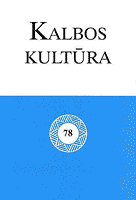Kalba kaip žmogaus įvaizdžio dalis
Language as part of one's image
Author(s): Rita MiliūnaitėSubject(s): Language and Literature Studies
Published by: Lietuvių Kalbos Institutas
Keywords: Image; context; standard language; language norms; influence; public opinion
Summary/Abstract: The paper sets out to examine how at the crossroads of linguistic and social factors images are created by linguistic means. It analyses the image of an individual and his/her language in the context of public standard language norms, language peculiarities exerting major influence on the public opinion about the individual. There are two types of data being analysed: 1) language phenomena on whose basis the image is created; 2) language users' opinion about the above phenomena. The data have been collected for ten years when observing the usage of the standard language and covering both: spoken and written language of mass media. The first part covers linguistic and social factors of creating the image, the second focuses on specific cases of creating the image by linguistic means or disclosed through language. The image can be created consciously (attempting to adjust to the existing language norms or by violating them); however, sometimes the image is disclosed unconsciously, when the speaker does not control himself/herself. Since standard language and its norms levels off specific features of individuals and their groups, the image might aim at 1) preserving one's neutral status, i.e. follow the norms of the standard language; 2) emphasizing one's specific features under certain circumstances. The most prominent language means to create/disclose one's image are as follows: 1) spelling, 2) features of spoken language (pronunciation, accent, intonation), 3) vocabulary (words, their meanings and word formation), 4) grammar (declensions and conjugations, usage of forms, collocations and sentences). When dealing with the standard language usage, there have been stereotypes of linguistic behaviour identified, which influence the image of an individual or a group of individuals: 1) literacy–illiteracy; 2) standard–non-standard pronunciation (i.e. dialectal, half dialectal, jargon, non-native); 3) normative–non-normative accentuation; 4) indigenous– borrowed lexicon, moderate modernity–retardation, morality–vulgarity. In accordance with the concept of standard Lithuanian, the image of prestige has clearly identifiable relations with observing codified norms in public life, which in their turn, are usually related to a higher layer of society as well as official communication style. The usage of other than prestigious language varieties in public life (except when it is done with a particular purpose in mind) may be related to the affiliation of such users with other layers, which is why the image of such speakers tend to lose the prestige.
Journal: Bendrinė kalba (iki 2014 metų – Kalbos kultūra)
- Issue Year: 2005
- Issue No: 78
- Page Range: 32-55
- Page Count: 24
- Language: Lithuanian

